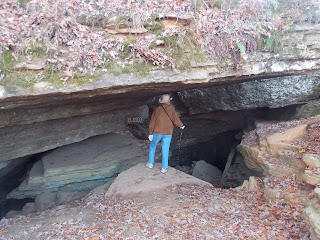It has taken us a bit longer than expected, but we are now in the northwestern corner of Arkansas. Deep in a valley of the rugged Boston Mountains is the Devil's Den State Park. The mountains are the southern end of the Ozark Highlands. Below is a picture of those mountains which I took at Lake Fort Smith Park.
John commented that he was tired of looking at old homes and he was ready for some hiking. Devil's Den is 2,500-acre park with some very spectacular Ozark Mountain scenery, some say that it is the best in Arkansas. It seemed the natural place for us to go for hiking, and we chose the most popular trail of the park. Devil's Den Trail took us over rugged rocky paths between high sandstone bluffs. Weathering and erosion have created the Swiss cheese look to the rock formation pictured below.
Crevices and caves are another feature of this park. Geologists believe that the crevices are a result of a major slide from the south of this area. The crevice pictured below is only a small part of the larger crack between two huge rock formations. A photo just does not do it justice. Light and shadows at that time of day did not help either. It was quite impressive and unlike anything we had ever seen.
The narrow steep-walled cave pictured below is the Devil's Den, for which the park is named. Some say it use to be a hideout for outlaws, but no one knows for sure.
Another feature of the trail is the Devil's Icebox. Large fractures as the "Icebox" were formed as cracks within the Atoka sandstone became enlarged as the large rock mass slid. During the summer air flowing out of this cave may feel cool to hot, sweaty hikers- hence the name "Icebox". It was a cool day for us and the air flowing out felt warm to us. Actually most caves in the park keep an even temperature of 55-60 degrees year- round. In the picture below John is checking out the "Icebox".
It would have been interesting to have explored some of the caves along the trail, but they are all currently closed to the public. Park rangers are fearful of the white-nose syndrome. It is a non-native cold-loving fungus which is destroying large bat populations. Fortunately it is not in this park. One other note, as we entered the park we saw what we thought was a road runner. We did not think they could be this far south but a park ranger assured us that they have been spotted in the park.
Wednesday, November 14, 2012
Subscribe to:
Post Comments (Atom)





No comments:
Post a Comment